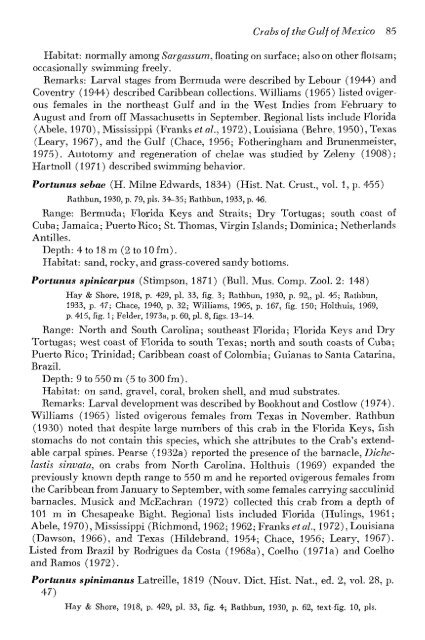You also want an ePaper? Increase the reach of your titles
YUMPU automatically turns print PDFs into web optimized ePapers that Google loves.
Crabs of the Gulf of Mexico 85<br />
Habitat: normally among Sargassuni, floating on surface; also on other flotsam;<br />
occasionally swimming freely.<br />
Remarks: Larval stages from Bermuda were described by Lebour (1944) and<br />
Coventry (1944) described Caribbean collections. Williams (1965) listed ovigerous<br />
females in the northeast Gulf and in the West Indies from February to<br />
August and from off Massachusetts in September. Regional lists include Florida<br />
(Abele, 1970), Mississippi (Franks et al, 1972), Louisiana (Behre, 1950), Texas<br />
(Leary, 1967), and the Gulf (Chace, 1956; Fotheringham and Brunenmeister,<br />
1975). Autotomy and regeneration of chelae was studied by Zeleny (1908);<br />
Hartnoll (1971) described swimming behavior.<br />
Porlunus sehae (H. Milne Edwards, 1834) (Hist. Nat. Crust., vol. 1, p. 455)<br />
Rathbun, 1930, p. 79, pis. 34-35; Rathbun, 1933, p. 46.<br />
Range: Bermuda; Florida Keys and Straits; Dry Tortugas; south coast of<br />
Cuba; Jamaica; Puerto Rico; St. Tliomas, Virgin Islands; Dominica; Netherlands<br />
Antilles.<br />
Depth: 4tol8m (2tolOfm).<br />
Habitat: sand, rocky, and grass-covered sandy bottoms.<br />
Porlunus spinicarpus (Stimpson, 1871) (Bull. Mus. Comp. Zool. 2: 148)<br />
Hay & Shore, 1918, p. 429, pi. 33, fig. 3; Rathbun, 1930, p. 92„ pi. 45; Rathbun,<br />
1933, p. 47; Chace, 1940, p. 32; Williams, 1965, p. 167, fig. 150; Holthuis, 1969,<br />
p. 415, fig. 1; Felder, 1973a, p. 60, pi. 8, figs, 13-14.<br />
Range: North and South Carolina; southeast Horida; Florida Ke5rs and Dry<br />
Tortugas; west coast of Florida to south Texas; north and south coasts of Cuba;<br />
Puerto Rico; Trinidad; Caribbean coast of Colombia; Guianas to Santa Catarina,<br />
Brazil.<br />
Depth: 9 to 550 m (5 to 300 fm).<br />
Habitat: on sand, gravel, coral, broken shell, and mud substrates.<br />
Remarks: Larval development was described by Bookhout and Costlow (1974).<br />
Williams (1965) listed ovigerous females from Texas in November. Rathbun<br />
(1930) noted that despite large numbers of this crab in the Florida Keys, fish<br />
stomachs do not contain this species, which she attributes to the Crab's extendable<br />
carpal spines. Pearse (1932a) reported the presence of the barnacle, Dichelastis<br />
sinvala^ on crabs from North Carolina. Holthuis (1969) expanded the<br />
previously known depth range to 550 m and he reported ovigerous females from<br />
the Caribbean from January to September, with some females carrying sacculinid<br />
barnacles. Musick and McEachran (1972) collected this crab from a depth of<br />
101 m in Chesapeake Bight. Regional lists included Florida (Hulings, 1961;<br />
Abele, 1970), Mississippi (Richmond, 1962; 1962; FrankseZo/., 1972),Louisiana<br />
(Dawson, 1966), and Texas (Hildebrand, 1954; Chace, 1956; Lear)^ 1967).<br />
Listed from Brazil by Rodrigues da Costa (1968a), Coelho (1971a) and Coelho<br />
and Ramos (1972).<br />
Porlunus spinimanus Latreille, 1819 (Nouv. Diet. Hist. Nat., ed. 2, vol. 28, p.<br />
47)<br />
Hay & Shore, 1918, p. 429, pi. 33, fig. 4; Rathbun, 1930, p. 62, text-fig. 10, pis.

















